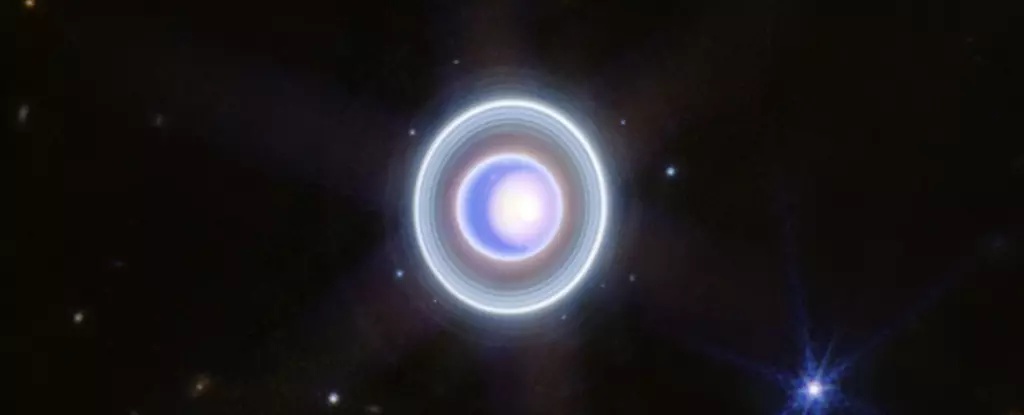For a long time, the seventh planet from the Sun, Uranus, has been shrouded in enigma. With measurements largely derived from the Voyager 2 mission, which flew past Uranus in 1986, scientists believed that they had gained a comprehensive understanding of this unusual gas giant. However, recent studies are suggesting that much of what we thought we knew about Uranus’s magnetic field might have been contingent on extraordinary solar conditions present during that historic flyby.
The Voyager 2 spacecraft has served as a vital bridge in our comprehension of Uranus, providing unprecedented close-up observations of the planet’s magnetosphere, atmosphere, and rings. Descriptions emerging from its sensory data characterized Uranus’s magnetic field as unclear and erratic, a departure from patterns observed in other gas giants like Jupiter and Saturn. Phrases like “a hot mess” have been employed to denote its curious off-center magnetic field and unstable radiation belts. Yet, these assessments primarily relied on a single moment in time during a weekend snapshot of a much larger continuum of space weather phenomena.
Space plasma physicist Jamie Jasinski, part of a team at NASA’s Jet Propulsion Laboratory, is revisiting these measurements with fresh skepticism. Through careful analysis of solar wind dynamics leading up to the Voyager flyby, Jasinski found that the conditions during the flyby may have been anomalous, thus calling into question the integrity of earlier findings.
Jasinski and his colleagues suggested that the unusual magnetic measurements taken by Voyager 2 might stem from a temporary burst of solar activity that coincided with the spacecraft’s observations. They discovered that, just prior to the flyby, the pressure of the solar wind had dramatically increased—by nearly 20 times—potentially altering the magnetosphere’s properties. This discovery has led the researchers to propose that the strange characteristics of Uranus’s magnetosphere observed during the Voyager encounter may not reflect its typical behavior but rather a fleeting phenomenon.
Given that the solar wind consists of charged particles expelled by the Sun, any intrusions that coincide with the magnetosphere can warp its shape and distort the magnetic field. Jasinski’s work draws parallels to phenomena observed with Mercury, where transient solar activity has been shown to significantly impact its magnetosphere. The findings indicate that if Voyager 2 had arrived at a different time, the data could have looked considerably different, thus underscoring the importance of time-sensitive observations in space science.
The implications of these findings are significant. If further studies corroborate Jasinski’s hypothesis, it would suggest a more stable and possibly similar magnetic environment for Uranus when not influenced by solar events. This challenges long-held views that the internal composition and magnetic field generation processes of Uranus set it apart from other gas giants within our Solar System.
A re-evaluation of Uranus could also inform theories concerning its structure and dynamics. The existing assumption that Uranus has a unique interior may need to be revised, and scientists may need to consider the influence of various stellar phenomena more seriously. Moreover, if the peak solar activities generated such a squashing effect on Uranus’s magnetosphere, it leads one to ponder how this may have affected the planet’s numerous moons and their potential habitability.
Given that our understanding is based on limited data from a single flyby, the scientific community is increasingly advocating for new exploratory missions directed at Uranus and Neptune. Such missions would gather a wealth of information, providing a comprehensive look at not only the planets themselves but also their unique magnetic fields and geological activities.
As Jasinski notes, important aspects of the Uranian system may have been hidden due to heightened solar dynamics around the time of the Voyager 2 flyby. For instance, alterations in the magnetosphere might have masked the presence of evidence for cryovolcanic activity on Uranus’s moons, consequently revising our understanding of the planetary system as a whole.
The study of Uranus is an ongoing endeavor in which every observation must be examined through the lens of changing solar conditions. The lessons learned from the Voyager 2 mission could radically reshape our understanding of not only Uranus but of planetary science as a whole. As we probe deeper into the complexities of our cosmic neighborhood, it becomes clear that the mysteries of the planets are far from solved, and the quest for knowledge in our Solar System remains a dynamic and evolving pursuit.

